|

|
EFN -
NEWS
Newsletter of the
Association EFN
11 September 2003 -
N°12
|
Radioactivity of the beach
at Espiguette
in the Camargue
This document is archived on
the internet and can be consulted at the following address:
http://www.ecolo.org/archives/archives-nuc-en/1-EspiguetteEN.htm
The association EFN visited the controversial
Espiguette beach on 15th July 2003 to make a scientific study of the
radioactivity, in order to better understand the situation, to
measure the radioactivity on the spot and thus to be better able to
inform the public in an objective manner on this current
controversial subject.
The French CRII-RAD (Commission de Recherche et
d'Information Indépendante sur la Radioactivité) made a
big splash in March and April 2000 after detecting an abnormally high
level of radiation on the Camargue beach to the east of the
Espiguette lighthouse
(1). A
subsequent study made by the BRGM (2)
(Bureau de Recherche géologique
et minière) showed clearly that the origin of this
radioactivity was entirely natural and due to the presence in the
beach sands of monazite, a mineral naturally rich in thorium and
uranium, most likely carried down in alluvial form by the waters of
the Rhone river. That seemed to put an end to the controversy, but it
popped up again at the beginning of the summer of 2003 following a
television broadcast (France 2, Envoyé Spécial, 19 June
2003) which re-opened the debate (3)
(4). Much to the distress of local
authorities and to the detriment of local tourist industry, some
antinuclear activists went so far as to propose that public access to
this so-called "contaminated" beach be restricted or even forbidden
(note: use of this term "contaminated" is in fact inappropriate in
reference to such small doses of natural radioactivity).
This three-mile long sun-bathed beach lies between
the sea and magnificent sand dunes. It is often said to be one of the
most beautiful beaches of the Mediterranean.
(5) For its
beauty and quiet it has become a favorite of tourists, and in recent
years it has been much frequented by amateurs of kite-skate and
kite-surf
(6).
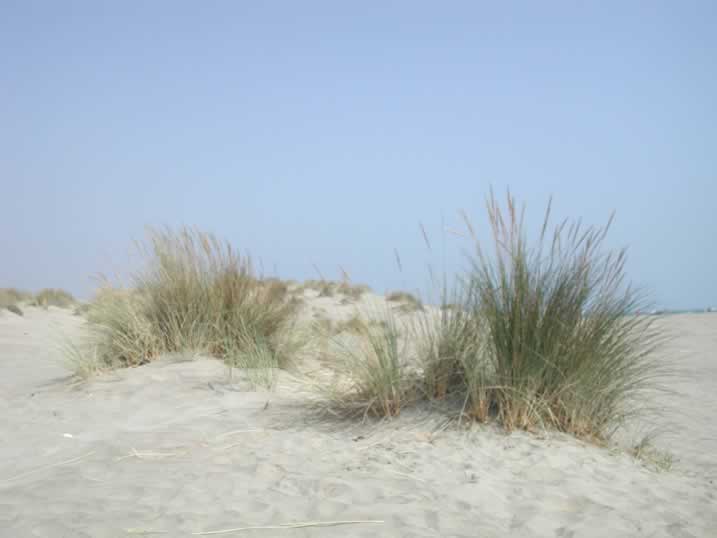
Sand dunes behind the Espiguette beach
(photo EFN)
For a panoramic view of the beach :
click
here
After the appearance of many, often contradictory,
radio and television broadcasts on the subject as well as newspaper
and magazine articles, it seemed to us that it would be useful to
make some measurements of our own. Thus a small team of EFN
researchers equipped with a Gammascout Geiger counter visited the
site to make a series of measurements of the radioactivity on the
beach. Our purpose was to have our own clear idea of the situation
and to know first-hand what we were talking about.
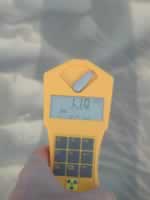
Gammascout Geiger counter (in this photo
: the radioactivity reads 1,10 microSievert/hour on the Espiguette
beach)
We first made a bibliographic study (see the
references below) and gathered documents to allow us to determine the
situation in detail and quantitatively. We relied extensively on the
BRGM
study
(2)
as well as other material.
Basing ourselves on this information we visited
the beach on 15th July 2003; we examined the beach and the dunes the
whole day long;
- we made measurements the entire length of the
beach going well beyond the radioactive zone; we covered at least 10
kilometers including the center of the town of Grau du Roi
;
- we identified the most radioactive places and
made profiles of the radioactivity along and across the beach and
dunes;
- we made three particularly detailed transverse
profiles : 1/ at the town of Grau du Roi which is at the most
frequented part of the beach; 2/ at the level of the Espiguette
lighthouse; and 3/ at that part of the beach where the radioactivity
is the highest.
- we took samples for later analysis.
- finally we compared these data with similar data
for other regions, more or less radioactive, but especially with our
own data gathered in 1999 at the beach of Guarapari (Brazil) well
before the beginning of the current controversy.
At the following address you will find photographs
taken during our visit. They give a visual impression of the site and
of the measurements we made there.
http://www.ecolo.org/photos/visite/espig_03-web/
(7)
About forty photos are displayed on that page;
each one can be enlarged to fill your screen simply by clicking on
it.

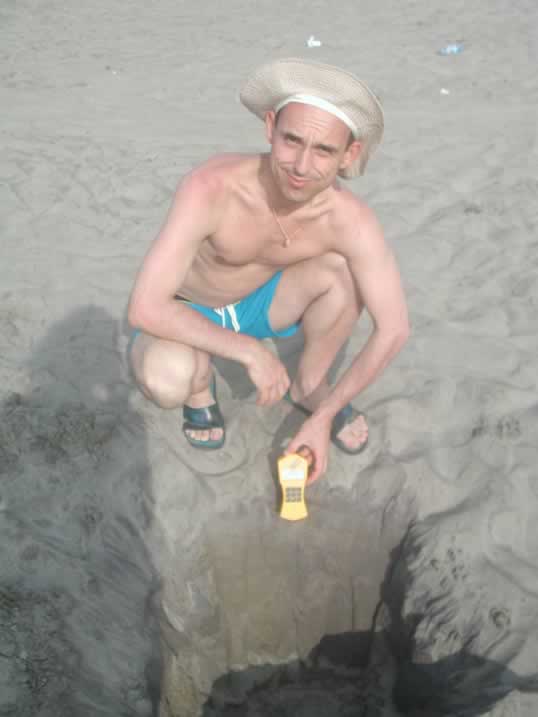
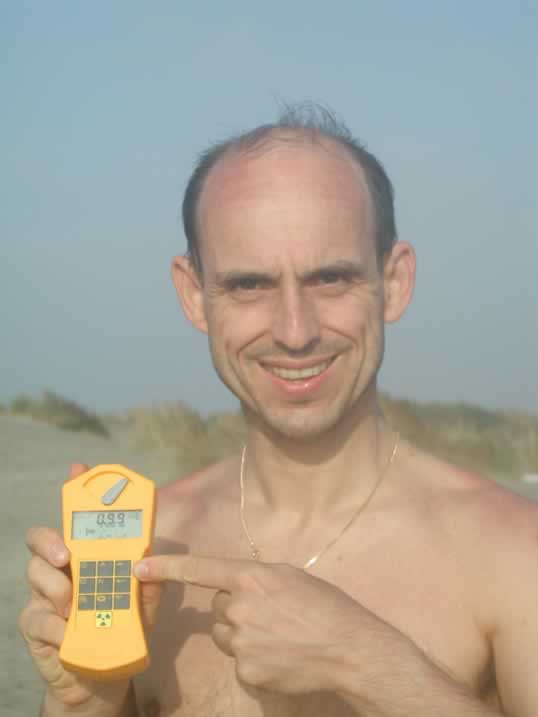
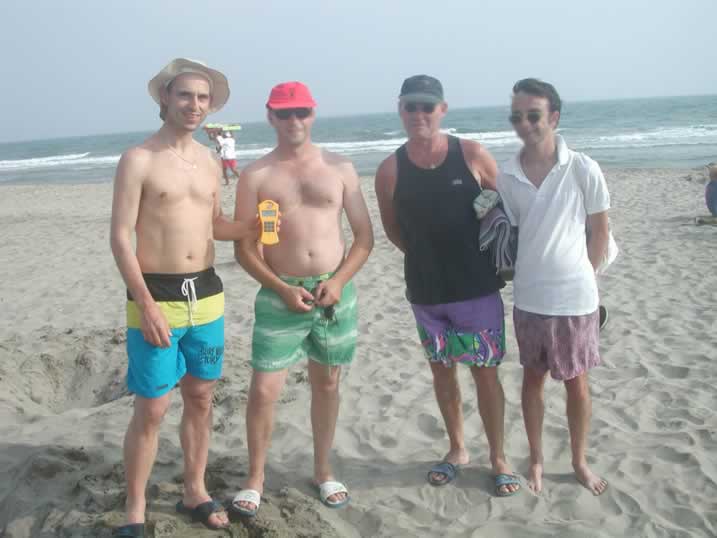
EFN measuring radioactivity on the
Espiguette beach
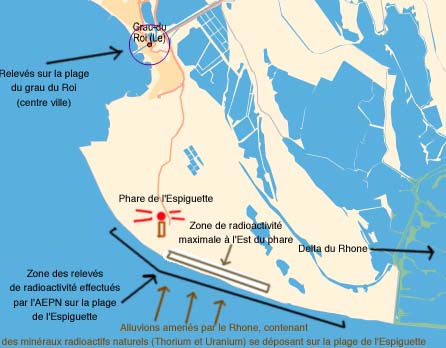
Map of the region studied
English legends inserted in the
illustrations:
Measurements on the beach at Grau du Roi (center of town)
Espiguette lighthouse;
Area of greatest radioactivity east of the lighthouse;
Delta of the Rhone;
Area of EFN's radioactivity measurements on the beach;
Alluvium containing naturally radioactive thorium and uranium is
carried down by the waters of the Rhone and deposited on the
beach.
In view of our measurements, we offer the
following conclusions:
- overall, our measurements confirm those of
CRII-RAD and BRGM. The radioactivity on the beach is indeed
greater than elsewhere, and the orders of magnitude reported in their
communications - up to 50 or 100 times greater than the background -
seem to be correct. (Our maximum readings were a bit less than those
reported by CRII-RAD, but this might be due to differences in the
calibration of our instruments and to the weather.) We differ with
that association when it comes to the interpretation of our results
and their consequences (or lack of consequences) for public health
(see below). Walking along the beach parallel to the water, we found
that the most radioactive area is indeed east of the Espiguette
lighthouse for about 2 kilometers. Starting at the lighthouse, the
radioactivity first increases slowly and then decreases equally
slowly. The most radioactive area is a small zone right in the
middle, about 1 kilometer east of the lighthouse and just before
reaching the nude beach.
- turning to the transverse profiles, that is
moving from the water's edge toward the interior and perpendicular to
the beach, there is practically no radiation above normal background
at the water's edge, but it increases slowly over a few tens of
meters as one walks toward the dunes. The most radioactive area is at
the very back of the beach, near the foot of the first dune. As one
climbs the dune and continues inland, the radioactivity diminishes.
We confirm the observation that the most radioactive area is the
intertidal zone, that part of the beach between the water's edge and
the summit of the first dune.
- the highest level of radioactivity we could find
was about 1.2 microSv/hour, about 20 times the usual background of
about 0.05 microSv/hour. This is about the same, maybe a bit less,
than reported by CRII-RAD which should be taken with some
reservation because background radiation normally varies considerably
from place to place. The
"hottest" point we ever encountered on the Espiguette beach, walking
up and down the beach all day long, was 1.2 microSv/hour; we wish to
stress the point that this is small compared to what we encountered
on the beach at Guarapari in Brazil, where the highest level was 40
microSv/hour, that is, some 30 times greater than the maximum found
on the beach at Espiguette. The beach at Guarapari is a much
frequented public beach for a town of some eighty thousand healthy
inhabitants.
- in terms of public health, the
first deleterious effects of radiation begin to appear at about 100
milliSv received in one single dose or in a short period of time. The
Academy of Science of France has recently confirmed this
fact
(8). One
would have to spend 10 years at the most radioactive point on the
Espiguette beach in order to accumulate such a dose. People who visit
that beach never stay more than a few hundred hours and indeed the
beach is practically deserted except for summer vacations. Lets
suppose that a vacationer spends three hours a day the beach for two
months and puts his towel down at the most radioactive point every
day; he would then get an accumulated dose of 0.2 milliSv, about a
hundred times below the threshold of dangerous exposure.
- in comparing Espiguette and Guarapari we remark
first off that the Espiguette beach is practically empty except in
the summer, while the beach at Guarapari is used all day long and all
year round, not only by the 80 000 inhabitants of the city but also
by thousands of tourists. The city is built close to the radioactive
beach with buildings facing the sea, as at Nice. The inhabitants are
no less healthy than elsewhere, and in fact the city has a reputation
of being healthy. In comparing the beaches we find that many fewer
people are exposed at Espiguette, perhaps ten times fewer, their
individual annual exposure is perhaps ten times less, for they go
only in the summer, the chance that one put one's beach towel down on
the hottest spot is small, and the exposure per unit time is perhaps
30 times smaller. No deleterious effect on health has ever been
detected even at Guarapari; quite the contrary, the city is noted for
its beneficial effects, precisely due to the radioactivity of the
black beach sands rich in monazite.
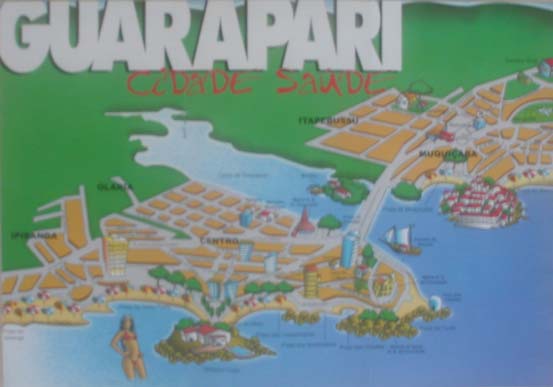

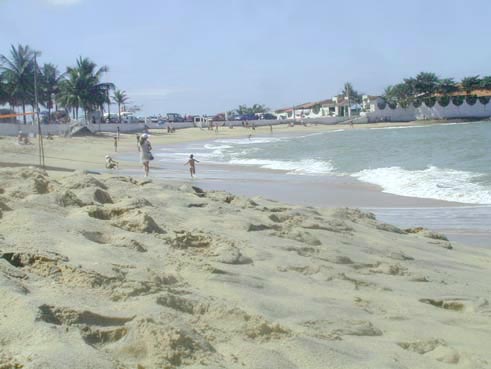
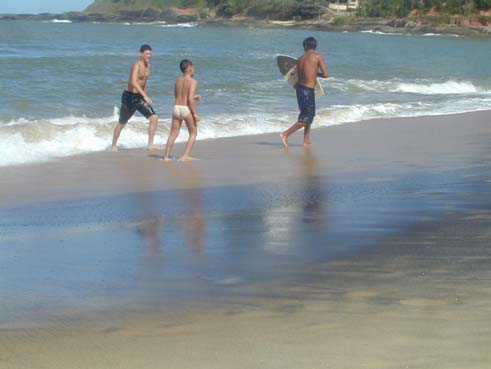
In the year 2000, EFN measured the
radioactivity on the beach at Guarapari in Brazil. The beach sands
there are particularly radioactive, the maximum value measured was 30
times greater than the maximum at Espiguette.
Another point of comparison:
during a flight at high
altitude from Paris to Tokyo or from Paris to San Francisco, one is
exposed to ionizing radiation which may be as high as 5 microSv/hour,
four times greater than at the "hottest" spot on the Espiguette
beach. During a 12-hour flight one might
be exposed to 60 microSv, which corresponds to about two weeks of
sunbathing at Espiguette for three hours a day, always at the
"hottest" spot on the beach. It is worth noting that studies of
airline flight personnel, who are continually exposed to high levels
of ionizing radiation, have shown no excess of cancers,
leukæmia or other diseases which might be linked to radiation.
In fact, the occurrence of cancers is smaller than in the population
at large.
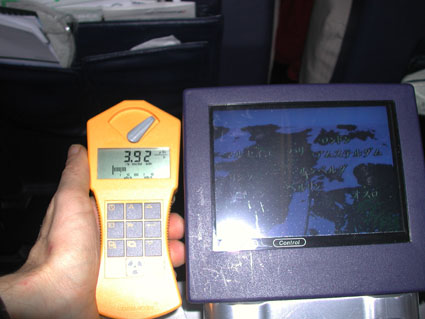
Ionizing radiation measured in an
airliner at high altitude: in this case 3,92 microSievert/hour at 11
600 meters = 38 500 feet.
In view of the doses one might receive, it
seems to us that we can declare with confidence that, as far as
ionizing radiation is concerned, there is NO DANGER whatsover to the
health of anyone who visits the beach at Espiguette. Overexposure to
the sun and drowning risks are the real hazards
there.
- we made similar measurements on the neighboring
beach opposite the center of the town of Grau du Roi where many more
people bathe. There too we found a very slightly elevated level of
radioactivity in the intertidal zone, some tens of meters wide, just
like at Espiguette. It seems to display the same profile and it
is undoubtedly of the same origin; it is due to monazite, bearing
thorium and uranium, which is part of the natural alluvium washed
down by the Rhone and washed up by ocean currents on the beaches near
the mouth of the river, just as at Guarapari. The radiation is 10
times weaker at the town of Grau du Roi than at the beach at
Espiguette, and 300 times weaker at Grau du Roi than at
the beach of Guarapari in Brazil.
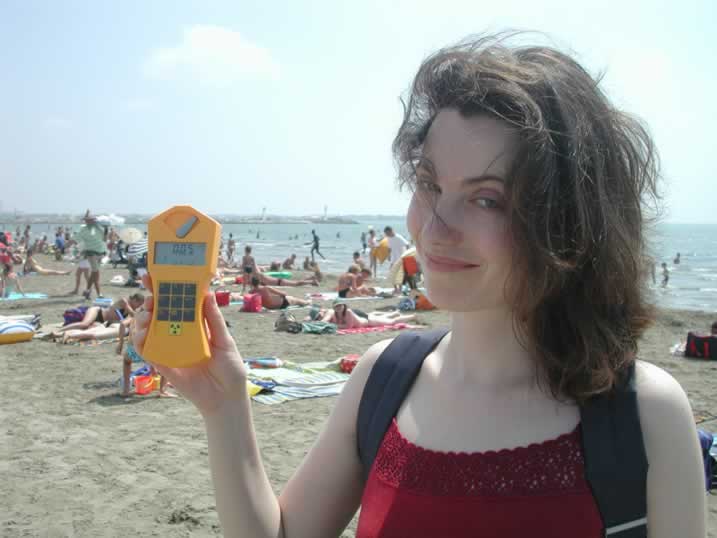
Measuring ionizing radiation at the beach
at Grau du Roi (near the center of town)
We have confirmed then that ionizing radiation at
the Espiguette beach far exceeds the average taken over all of France
- up to 50 times more at certain well defined points - and it is of
course greater than on the granitic beaches of Brittany. It is
nevertheless far smaller (perhaps by a factor of 100) than the levels
which might constitute a health hazard, even for the rare sunbather
who consistently visits that small area of the beach where the
radioactivity is greatest.
No particular precautions need to be taken; quite
the contrary, it might be advisable to visit regularly so as to take
advantage of the beneficial effects of small doses of radiation which
stimulate the immune system (the effect is known as hormesis). And it
would be even better to vacation at Guarapari in Brazil where the
effect is about 30 times greater.
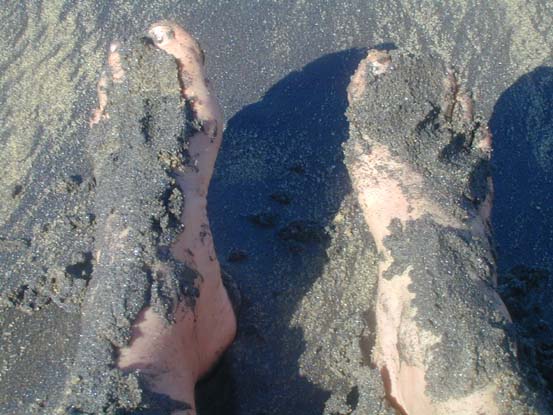
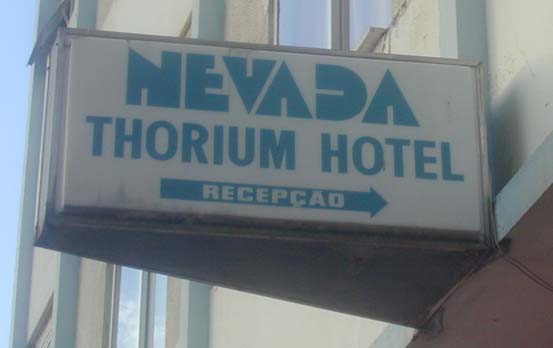
The radioactive baths at the beach at
Guarapari are so well known in Brazil for their curative effects that
there is even a Thorium Hotel, and the city is dubbed "Cidade da
Saude" (health city). The black beach sands are especially rich in
thorium and people who go there for the cure are advised to cover
their bodies with the black sand for up to 10 minutes for the first
few days and then for up to 20 minutes at a time.
Photos of the beach at Espiguette and of
measurements being made by EFN:
http://www.ecolo.org/photos/visite/espig_03-web/
Photos of the beach at Guarapari and of
measurements being made by EFN:
http://www.ecolo.org/photos/visite/guarapari_00/
Position of BRGM regarding the
radioactivity of the beach at Espiguette:
http://www.brgm.fr/BRGMFrance/espiguet.htm
We intend to publish at some later date more exact
results of this research including both longitudinal and transverse
profiles, as well as the results of the analysis of the samples of
beach sand. However the analysis will be costly, and we seek
contacts who might be willing to execute those studies for us or to
finance them - we require mineralogical, radiological and chemical
analyses of the samples we gathered at Guarapari as well as at
Espiguette.
Please contact
us (spam prevention: replace [at]
by @ in the email address) if you think you might be able to help us
or if you have some ideas or suggestions about this subject.
To recapitulate, we confirm the radiation levels
reported by CRII-RAD as well as the conclusions of the studies of
BRGM, of IPSN and OPRI now joined in IRSN
(10).
However their frightening interpretations and CRII-RAD's fear that
the beach might be dangerous has, in our opinion, no scientific
foundation.
To be more explicit, the exploitation of this
affair by the media - radio, television and press - is nothing but a
hoax, making a lot of noise for no reason whatsoever. CRII-RAD has
actually discovered nothing new, because the high level of natural
radioactivity on the Espiguette beach has been known for a long time.
It was indeed the subject of a communication by the geologist
André Rivière presented before the Academie des
Sciences in ... 1955
(11). The
following year, André Rivière published the results of
his study in the Bulletin de la Société
Française de Géologie under the title "The accumulation
of sediment in the Rhone, its transport to the Mediterranean beaches
and the concentration of naturally radioactive material on the beach
at Espiguette"
(12).
So the level of radioactivity on the Espiguette
beach was already known to be higher than elsewhere and its origin
already identified, well before the first nuclear installation began
to operate in the Rhone valley - that was the plant at Marcoule which
opened in 1958. The whole affair is warmed over porridge which
the CRII-RAD and the media tried to present as a new
discovery.
So there's nothing new, and no danger nor any
hazardous condition on the beach at Espiguette, where vacationers can
continue to sunbathe in all serenity. The radiation there is natural
and totally inoffensive, and may even be beneficial.
And it's not even a unique phenomenon. Natural
monazites, rich in uranium and thorium, are found in the beach
sands near the estuaries of several rivers - at Guarapari in Brazil
and in the province of Kerala in India - and they have been there for
such a long time that no one can say when they appeared. The nuclear
industry has nothing to do with it, as some people will be sorry to
learn, but it is completely natural that the distribution of
radioactivity from place to place is variable, sometimes highly
variable. It's a natural phenomenon, and it's not dangerous at the
levels encountered.
Have a good day!
Bruno Comby
President of EFN
______________________________
References :
(1) - CRII-RAD, "Anomalie radiologique sur
certaines plages de la petite Camargue", 13 avril 2000,
http://www.criirad.com/criirad/actualites/Communiques/Camargues13avril.html
(2) - BRGM "Expertise géologique des
anomalies radioactives des plages de Camargue : plage de
l'Espiguette, le point de vue sur la radioactivité", document
mis a jour le 28 11 02
http://www.brgm.fr/BRGMFrance/espiguet.htm
(3) - Marc Filterman, "Plages radioactives en
Camargue", juillet/aout 2003, http://membres.lycos.fr/filterman/radioactif-plage-camargue.htm
(4) - La Provence, "La radioactivité des
plages de Camargue ressurgit", 20 juin 2003, http://www.sortirdunucleaire.org/juin2003/laprovence200603.htm
(5) - Avignon et Provence, "La plage de
l'Espiguette", site web : http://www.avignon-et-provence.com/camargue/fr/diaporama/03-camargue.htm
(6) - Web site KiteSkate.com, "L'Espiguette"
http://kiteskate.free.fr/kiteskate/francais/spot/espiguette/espiguette.php
(7) - AEPN - Campagne de mesure de la
radioactivité à Guarapari au Brésil, juin 1999,
http://www.ecolo.org/photos/visite/espig_03-web/
,
(8) - Avis de l'Académie de Médecine
du 4 décembre 2001, http://www.ecolo.org/documents/documents_in_french/Irrad-Dechets-AvisAcadMed.htm
(9) - ASN (Autorité de sûreté
nucléaire), "Note d'information relative à la
radioactivité naturelle de certaines plages de Camargue", 20
juin 2003, http://www.asn.gouv.fr/data/information/25_2003_camar.asp
(10) - IRSN - "Dépôts
sédimentaires radioactifs sur le littoral de Camargue", Juin
2003 http://www.irsn.fr/vf/05_inf/05_inf_1dossiers/05_inf_30_camargue/05_inf_30_1camargue.shtm
(11) - André Rivière, Note
présentée à l'Académie des Sciences en
1955, cité par l'IRSN, "Note d'information sur la
radioactivité naturelle de certaines plages de Camargue", juin
2003, http://www.irsn.fr/vf/05_inf/05_inf_1dossiers/05_inf_30_camargue/
pdf/NI_sables_camargue_juin03.pdf
(12) - André Rivière, Bulletin de la
Société Française de Géologie, 1956,
cité par Jean Brissonnet d'AFIS-Sciences dans "Radiophobie,
fantasmes et réalités", http://www.pseudo-sciences.org/radiophobie.htm















